
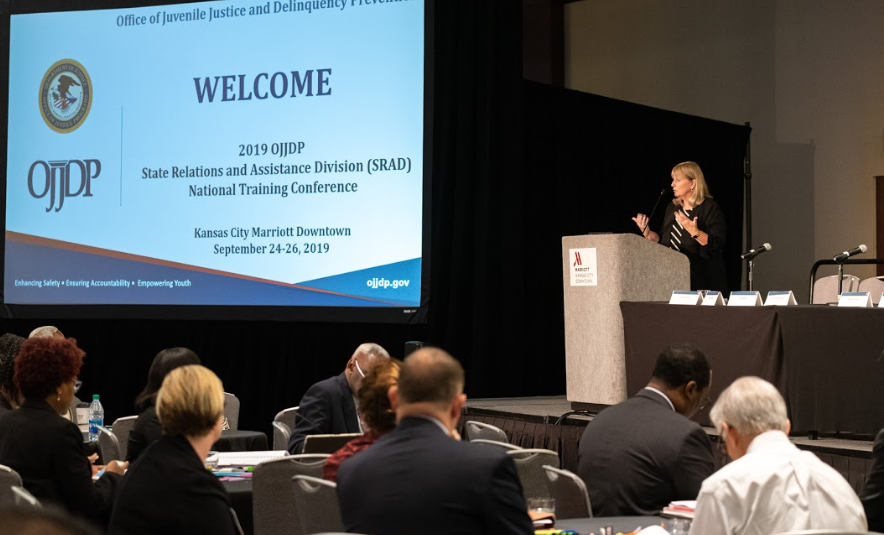 Administrator Harp addresses conference attendees.
Administrator Harp addresses conference attendees.OJJDP’s National Training Conference, held on September 24–26, 2019, in Kansas City, MO, offered a wealth of information and resources to help states and territories prevent delinquency and improve the juvenile justice system.
Approximately 200 participants engaged in interactive discussions, panels, and workshops to enhance implementation of OJJDP’s Title II Formula Grants program and support compliance with the core requirements of the Juvenile Justice and Delinquency Prevention (JJDP) Act. Participants included representatives from state agencies designated to oversee members of state advisory groups, OJJDP leadership and staff, staff from the Center for Coordinated Assistance to States, and federal partners. The conference was organized by OJJDP's State Relations and Assistance Division (SRAD).
OJJDP Administrator Caren Harp kicked off the conference with an update on the Juvenile Justice Reform Act (JJRA) of 2018. Administrator Harp also announced the release of An Overview of Statutory and Regulatory Requirements for Monitoring Facilities for Compliance with the Deinstitutionalization of Status Offenders, Separation, and Jail Removal Provisions of the Juvenile Justice and Delinquency Prevention Act. This document is intended to assist states in their execution of the Formula Grants program. Administrator Harp and OJJDP staff later led special sessions and state discussions on key JJRA provisions, including new expectations regarding juveniles handled in adult court, the use of the valid court order exception, and an effective system of monitoring for compliance with the JJDP Act.
OJJDP unveiled a new online resource—webpages for each state and territory that enable state agency staff to view Title II funding determinations, learn whether a state or territory participates in the Formula Grants program, and access 3-year state plans. The webpages also provide compliance information, disproportionate minority contact (DMC) data, performance measures, and a list of active OJJDP formula and discretionary awards for each state and territory.
—Joseph Vignati, Chair
Federal Advisory Committee on Juvenile Justice
OJJDP also offered a “walkthrough” of the updated features and content of the Office’s online Compliance Monitoring Tool, which had been under revision to incorporate OJJDP policy changes. The tool allows states to upload data on compliance with JJDP Act requirements to a central repository, and its comprehensive questionnaire elicits details about each state and territory’s violations or use of standard exceptions and automatically calculates annual compliance rates. In addition, OJJDP provided a basic training for new juvenile justice specialists, compliance monitors, and DMC coordinators. The training focused on roles and responsibilities for each position and offered an overview of the JJDP Act and Formula Grants program.
To connect Title II-related work within the Office, OJJDP’s Federal Advisory Committee on Juvenile Justice (FACJJ), composed of 14 state advisory group members, shared their current priorities, which include facilitating compliance with the JJRA, addressing the needs of at-risk youth in rural areas, and developing an online gateway to information, resources, and training for practitioners in the juvenile justice field. FACJJ is responsible for making recommendations on juvenile justice issues to the President, Congress, and OJJDP.
To highlight support available for states and territories through other federal agencies, representatives of the Department of Health and Human Services’ Runaway and Homeless Youth program and the Department of Education’s Title I program discussed funding opportunities and federal-state partnerships available through their agencies. The White House’s Office of National Drug Control Policy shared information about how to access resources to address challenges associated with substance abuse in rural communities, including unemployment and difficulty in accessing medical care and social services.
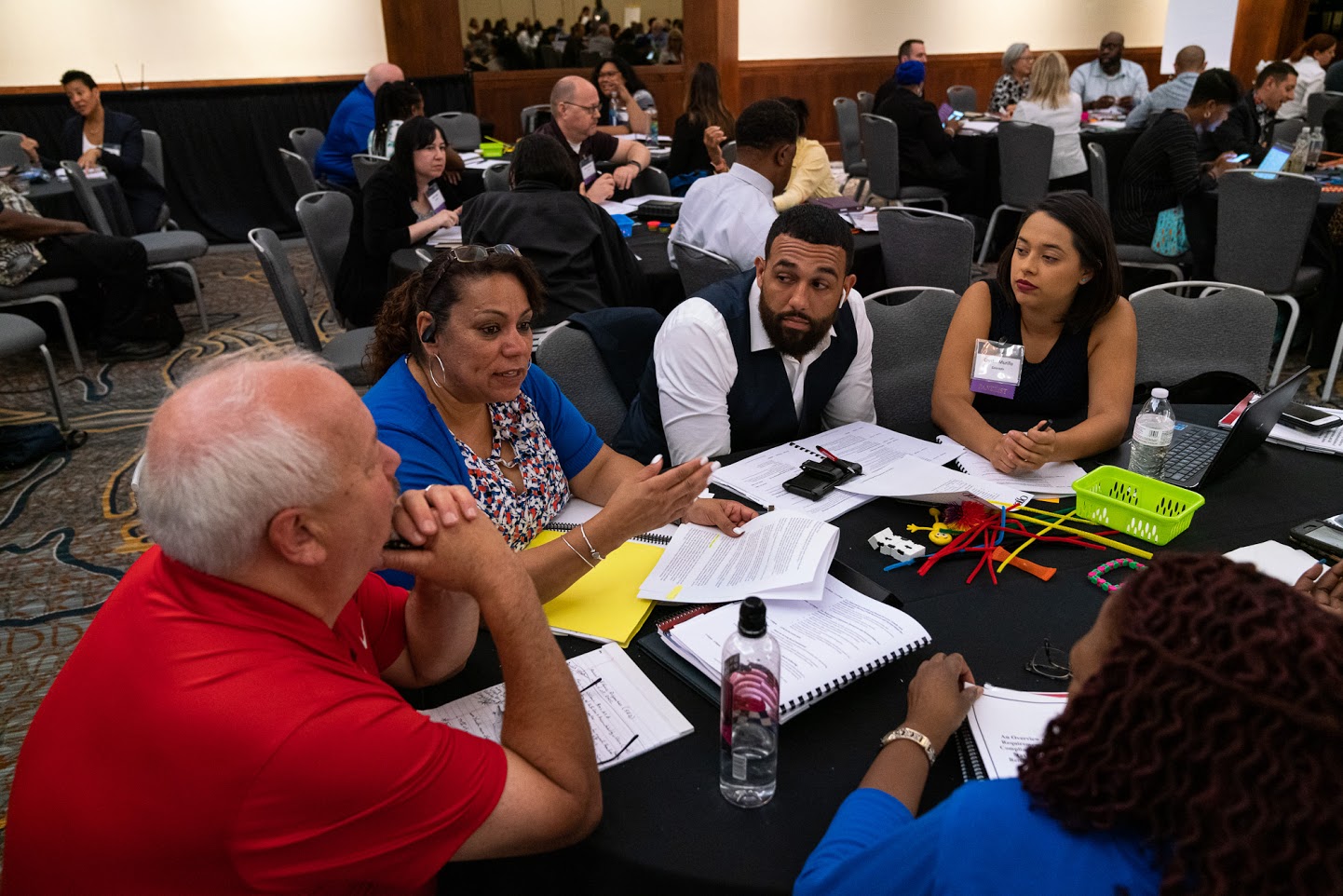 Breakout sessions facilitated networking and peer learning among attendees. Conference sessions explored local examples and ideas for improving juvenile justice policy and practice in a range of areas. Topics included community partnerships to effectively put DMC reduction plans into action, support of territories in implementing Title II and the core requirements, the use of data to drive decisionmaking, the development of strong infrastructures for state advisory groups, outreach to tribal communities, youth engagement, trauma-informed systems of care, and restorative and balanced justice practices.
Breakout sessions facilitated networking and peer learning among attendees. Conference sessions explored local examples and ideas for improving juvenile justice policy and practice in a range of areas. Topics included community partnerships to effectively put DMC reduction plans into action, support of territories in implementing Title II and the core requirements, the use of data to drive decisionmaking, the development of strong infrastructures for state advisory groups, outreach to tribal communities, youth engagement, trauma-informed systems of care, and restorative and balanced justice practices.
Conference topics were determined through a review of past training feedback, suggestions from a field advisory team, and SRAD and OJJDP leadership discussions. Workshops helped OJJDP determine practitioners' training and peer networking needs, capture their thoughts on the new JJRA provisions, and gather feedback on topics of special interest to OJJDP, such as youth and family engagement.
Concurrent with the national training conference, OJJDP convened an in-person meeting of FACJJ. For information on the FACJJ meeting, read “News From the Federal Advisory Committee on Juvenile Justice” in this issue.
Resources:
To learn more about compliance with the JJDP Act’s core requirements and program areas supported by the Formula Grants program, visit the OJJDP website.
View OJJDP’s 2018 JJRA Redline document, which allows users to closely track changes implemented by JJRA.
Read OJJDP’s fact sheet Key Amendments to the Juvenile Justice and Delinquency Prevention Act Made by the Juvenile Justice Reform Act of 2018. The publication describes the major components of JJRA, including the effective application date, definition of terms, annual reporting requirements, state allocations, state plan requirements, and the status of funds not allocated due to state noncompliance.
Video recordings of the training conference’s opening day and OJJDP interviews with individual participants will be available soon on the OJJDP website.
Resources:
To learn more about compliance with the JJDP Act’s core requirements and program areas supported by the Formula Grants program, visit the OJJDP website.
View OJJDP’s 2018 JJRA Redline document, which allows users to closely track changes implemented by JJRA.
Read OJJDP’s fact sheet Key Amendments to the Juvenile Justice and Delinquency Prevention Act Made by the Juvenile Justice Reform Act of 2018. The publication describes the major components of JJRA, including the effective application date, definition of terms, annual reporting requirements, state allocations, state plan requirements, and the status of funds not allocated due to state noncompliance.
Video recordings of the training conference’s opening day and OJJDP interviews with individual participants will be available soon on the OJJDP website.
On October 1, 2019, OJJDP unveiled a redesigned website at a new web address: ojjdp.ojp.gov. The site offers a modern look and feel as well as enhanced technology to provide stakeholders with direct access to the latest information and news about OJJDP and its programs, blogs, publications, videos, trainings, and more. OJJDP redesigned the website with the support of the Office of Justice Programs’ (OJP’s) Office of the Chief Information Officer.
The new website provides stakeholders with a simplified and more user-friendly experience:
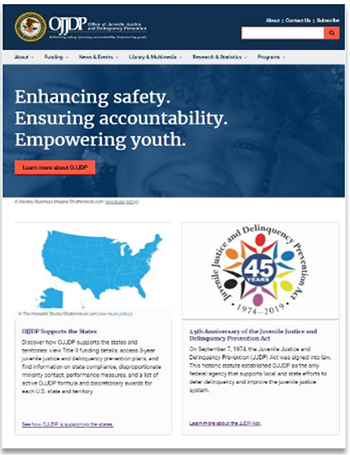 Technological Improvements
Technological Improvements
- Improved search. For the first time, the OJJDP website offers robust, state-of-the-art global search capabilities. Visitors can search by keyword and narrow search results by type of information, such as funding and awards, programs, events, publications, and multimedia. Search results can be sorted by date or relevance. Many webpages allow visitors to search within the page content or use filters to find exactly what they need.
- Web design. A simplified and modern design and layout for the OJJDP website takes advantage of design elements from the U.S. Web Design System and is compliant with Section 508 of the Rehabilitation Act, ensuring that information on the site is accessible to everyone.
- OJP family of websites. The OJJDP website redesign closely follows the recent redesign of the National Institute of Justice’s website. The upcoming redesign of all OJP bureau and program office websites will feature common web designs and leverage shared technologies, so visitors can go to various OJP websites with ease.
- Device friendly. The responsive site now ensures a successful web experience, whether visitors are accessing the site on a desktop, tablet, or mobile device.
- Updated information architecture. Updated site navigation provides direct access to key information.
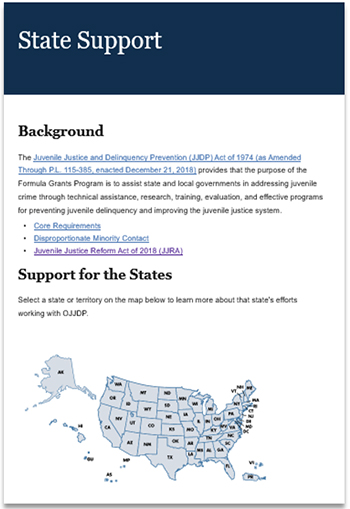 New Web Content
New Web Content
- Support for the states. The website now features detailed information about OJJDP’s relationship with the states and territories. The state pages focus on Title II Formula Grants funding determinations and reporting in a range of areas, including state 3-year plans, compliance information, and disproportionate minority contact. The pages also provide a listing of all active OJJDP awards for individual states and territories.
- Funding awards. Visitors can now find information about grants and cooperative agreements awarded by OJJDP. The information can be searched by award status, state, fiscal year, or keyword.
- Multimedia. OJJDP is working to expand the availability of videos and now offers a multimedia page that includes video messages from the OJJDP Administrator, training videos, archived webinars, speeches, and other videos of interest.
OJJDP is committed to providing information to stakeholders in support of its activities and mission. The Office will continue to add new features to the website and welcomes feedback. Provide feedback to OJJDP’s Web Content Manager.
Visit the new OJJDP website at ojjdp.ojp.gov.
 Gangs are responsible for a significant portion of violence and crime in many localities, and studies of large urban samples reveal that gangs account for a major portion of violent offenses committed during the adolescent years. To highlight the administration’s commitment to addressing gang-related threats to public safety, President Donald Trump proclaimed September 15–21, 2019, as National Gang Violence Prevention Week.
Gangs are responsible for a significant portion of violence and crime in many localities, and studies of large urban samples reveal that gangs account for a major portion of violent offenses committed during the adolescent years. To highlight the administration’s commitment to addressing gang-related threats to public safety, President Donald Trump proclaimed September 15–21, 2019, as National Gang Violence Prevention Week.
OJJDP’s work to reduce gang violence and crime spans several decades and includes programs, research publications, and support of the National Gang Center (NGC). The center offers an array of resources and tools, including online trainings, informational videos, and information about OJJDP's Comprehensive Gang Model. The model focuses on the coordination of prevention, intervention, and suppression efforts guided by appropriate information-sharing protocols. It highlights a holistic approach that involves all agencies and organizations in the community that are responsible for addressing gang-related crime and violence. A recent blog by an OJJDP grantee describes how the Comprehensive Gang Model is helping young people who are being negatively impacted by gangs, violence, and other associated risk factors.
—A Law Enforcement Official's Guide to the OJJDP Comprehensive Gang Model
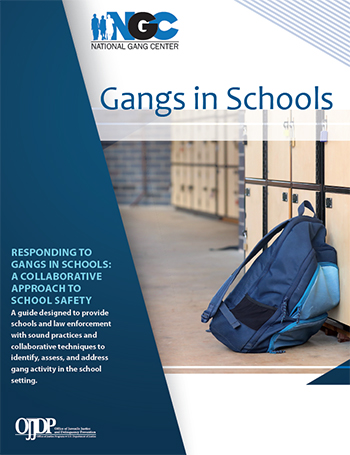
In August, OJJDP and NGC presented "Responding to Gangs in Schools: Creating a Collaborative Process Between Schools and Law Enforcement." The webinar discussed the importance of responding to gangs in a school setting, the specific roles of law enforcement and school administrators in developing partnerships to ensure school safety, and strategies to foster and sustain these partnerships. A followup webinar in September, "Recognizing Gang Activity in Schools," provided an overview of common gang identifiers and emphasized the importance of information sharing between school personnel and local law enforcement to ensure strategic planning and response.
In fiscal year (FY) 2019, OJJDP awarded $7.4 million to support communities as they work to deter and suppress gang activity and provide services and treatment to victims of gang-related violence and crime. FY 2019 programs include—
- Youth Gang Desistance/Diversion Grant Program. Assists jurisdictions struggling with high levels of youth gang violence as they implement one or more components of OJJDP’s Comprehensive Gang Model as part of a community- and data-driven desistance/diversion response to gang violence and crime.
- Youth Gang Suppression Implementation Grants Program. Helps jurisdictions prevent or reduce gang violence through the implementation of suppression strategies outlined in OJJDP’s Comprehensive Gang Model.
- Supporting Victims of Gang Violence Grant Program. Provides direct support services for victims of gang violence and strengthens the responses to children and youth exposed to gang violence in their homes, schools, and communities.
- National Gang Center. Disseminates information that empowers communities with chronic and emerging gang problems to create comprehensive solutions to gang violence, gang involvement, and gang-related crime.
Resources:
OJJDP's new Gang Violence Prevention webpage and video offer information about OJJDP resources and programs that prevent and suppress gang violence and recruitment.
For more information about the National Gang Center, read the “Stakeholder’s Corner” article in this issue.
To learn more about research findings on gang activity and gang prevention, read the literature review in OJJDP’s Model Programs Guide. See also the guide’s evaluations of programs that address gang violence and crime.
A Law Enforcement Official's Guide to the OJJDP Comprehensive Gang Model provides information on how to effectively implement the model, including the importance of agency buy-in and collaboration with citizens and organizations to address both the immediate threat of youth gangs and the underlying conditions that allow them to exist.
According to the Centers for Disease Control and Prevention, more than 700,000 Americans died from a drug overdose between 1999 and 2017, and about 68 percent of the drug overdose deaths in 2017 involved opioids. The rate of opioid overdose deaths among youth ages 15–24 has increased significantly since 1999, with 4,094 deaths in this age group in 2017. In addition to its tragic toll on human life, the opioid epidemic is having a profound effect on communities by disrupting public safety and increasing the burden for the law enforcement, child welfare, community health, corrections, and judicial systems.
OJJDP applauds the administration’s proclamation of October 2019 as National Substance Abuse Prevention Month. Through the following fiscal year 2019 grants, the Office remains steadfastly committed to supporting states and communities as they work to prevent and treat substance abuse and assist in the recovery of those who have been impacted:
- Opioid Affected Youth Initiative. Multidisciplinary task forces—with representatives from a range of community sectors, including law enforcement, health, education, the juvenile courts, child welfare agencies, and child protective services—are identifying specific areas of concern, collecting data to help coordinate efforts and resources, and providing intervention, prevention, and diversion services for youth and families directly impacted by opioid abuse.
- Mentoring Strategies for Youth Impacted by Opioids. As part of its Mentoring Opportunities for Youth initiative, OJJDP supports youth mentoring organizations that have a demonstrated partnership with a public or private substance abuse treatment agency. Mentoring includes a focus on preventing youth from using opioids in the first place, ensuring that youth who have used opioids are successful in their recovery efforts, and providing support and guidance to youth with family members who are currently abusing or have abused opioids.
- Drug Treatment Courts Training and Technical Assistance Program. This initiative helps drug treatment court programs increase their effectiveness through research-based services; consistent and efficient case planning, monitoring, and supervision procedures; and the use of performance measures to improve drug court case processing and service delivery. Training and technical assistance are provided to OJJDP’s Family Drug Court Program, Juvenile Drug Treatment Court Program, and the Tribal Healing to Wellness Courts Initiative.
- Family Drug Court Program. Family drug courts serve parents who require treatment for a substance abuse disorder and who are involved with the child welfare system as a result of child abuse, neglect, or other parenting issues. This program builds the capacity of state, local, and tribal governments to sustain existing family drug courts or establish new ones.
- Juvenile Drug Treatment Court Program. Juvenile drug courts are dockets within juvenile courts for cases involving substance-abusing youth in need of specialized treatment services. These courts allow for intensive judicial supervision of youth that would not ordinarily be available in the traditional juvenile court process. This program provides resources to create and enhance juvenile drug court programs for youth with substance abuse problems specifically related to opioid abuse or co-occurring mental health disorders, including histories of trauma.
- Tribal Juvenile Healing to Wellness Courts Initiative. As part of the Department of Justice’s Coordinated Tribal Assistance Solicitation, this initiative enhances the capacity of tribal courts to respond to the alcohol and substance abuse issues of youth who are younger than 21. Tribal Juvenile Healing to Wellness Courts strive to increase individual and community safety by holding youth accountable for delinquent behaviors while also providing therapeutic processes within a culturally supportive framework.
Resources:
OJJDP’s Model Programs Guide is a resource for practitioners and communities about what works, what is promising, and what does not work in juvenile justice, delinquency prevention, and child protection and safety. Read the guide’s evaluations of programs in the areas of substance abuse prevention and treatment, mentoring, juvenile and family drug courts, and family reunification.
Watch webinars describing OJJDP's FY 2019 Opioid Affected Youth initiative, Mentoring Opportunities for Youth initiative, and Family Drug Courts program.
Read OJJDP’s The Tribal Juvenile Healing to Wellness Court—Understanding Systems and Impacting Youth.
By the National Gang Center Team
 Street gangs have a significant adverse impact on youth and communities across America. Gang activity is a complex social phenomenon that varies by age, degree of gang involvement, and severity of offense. Sustainable solutions must involve comprehensive approaches that contain the spread of gang activity, protect youth who are most susceptible, and hold those engaged in gang violence and crime appropriately accountable. The OJJDP-supported National Gang Center (NGC) is a leading resource for law enforcement agencies, juvenile justice and criminal justice practitioners, policymakers, and community stakeholders seeking solutions to gang violence and crime.
Street gangs have a significant adverse impact on youth and communities across America. Gang activity is a complex social phenomenon that varies by age, degree of gang involvement, and severity of offense. Sustainable solutions must involve comprehensive approaches that contain the spread of gang activity, protect youth who are most susceptible, and hold those engaged in gang violence and crime appropriately accountable. The OJJDP-supported National Gang Center (NGC) is a leading resource for law enforcement agencies, juvenile justice and criminal justice practitioners, policymakers, and community stakeholders seeking solutions to gang violence and crime.
NGC provides training and technical assistance to cities and jurisdictions, both rural and urban, with chronic and emerging gang problems. The center helps communities navigate available gang-related programs, practices, and strategies to select what is most appropriate to address local needs. As a result of their collaboration with NGC, communities increase their capacity to assess the extent of their gang problems, develop strategic plans, and effectively implement gang-reduction initiatives using data-driven solutions.
The center currently maintains the most extensive and up-to-date compilation of gang-related research, publications, evidence-based and promising gang programs, training opportunities, programming tools, and gang legislation available online. Since 2003, NGC has been cataloging gang-related news covering the United States and Canada through the center’s Gang-Related News Articles webpage. With more than 46,000 articles, this resource is the most visited page on the NGC website, with an average of 29,500 page views a month. The success of this resource is due in part to the consistency of its daily updates—an average of 10 articles a day. Excerpts and links to articles that are published on the page can be filtered by state or province.
—Meena Harris, Director
National Gang Center
 G.R.E.A.T. instructor Robert Henderson of the Indianapolis Metropolitan Police Department (IMPD) impacted one of his students, Samone Willis, in a way that set her on a life-changing path. Shown on the left are Officer Henderson and Samone in the late 1990s, when Henderson visited her school to teach the G.R.E.A.T. curriculum. Inspired by Henderson, Samone decided to pursue a career in law enforcement. She is now a police officer with IMPD (see photo at right).
G.R.E.A.T. instructor Robert Henderson of the Indianapolis Metropolitan Police Department (IMPD) impacted one of his students, Samone Willis, in a way that set her on a life-changing path. Shown on the left are Officer Henderson and Samone in the late 1990s, when Henderson visited her school to teach the G.R.E.A.T. curriculum. Inspired by Henderson, Samone decided to pursue a career in law enforcement. She is now a police officer with IMPD (see photo at right).
Photos courtesy of Indianapolis Metropolitan Police Department and Aaron Cantrell.
NGC’s Law Enforcement Anti-Gang Training series offers instruction on basic and advanced gang investigations and gang unit supervision, as well as seminars for law enforcement chief executives. The classes are provided on a regional basis and include participants from all law enforcement agencies within a geographical region. More than 4,700 law enforcement officers throughout the United States have received training to identify and counter violent and criminal gang-related activities.
Community-based training topics include the OJJDP Comprehensive Gang Model, which provides a framework for coordinated action that improves a community’s capacity to prevent youth from joining gangs and reduce street gang violence and crime. More specialized training and technical assistance is available on request.
Resources:
Information and resources for assessing community gang problems and implementing intervention, prevention, and suppression strategies are available on the National Gang Center website.
Watch "Why Youth Join Gangs," a video that shares insights from researchers and practitioners as well as young people who were previously involved in gangs on the risk factors and behaviors associated with joining a gang.
The recently released Gangs in Schools offers schools and law enforcement sound practices and collaborative techniques to identify, assess, and address gang activity in the school setting.
Parents’ Guide to Gangs provides parents with answers to common questions about gangs to enable them to recognize and prevent gang involvement.
Over the past decade, safe harbor laws for young victims of commercial sexual exploitation have proliferated at the state level. These laws are designed to protect youth from punitive sanctions and instead refer them to youth-serving agencies that can provide supportive services. The laws are based on the premise that these crimes should be understood as acts of abuse and violence against youth and that minors who are exploited commercially for sexual purposes should not be considered criminals, but rather victims and survivors.
OJJDP recently released the findings of a study that examined safe harbor laws in the United States. Conducted by Development Services Group, Inc., the three-phase study examined the evolution of safe harbor laws and quantitatively and qualitatively assessed the laws’ impact on the commercial sexual exploitation of children (CSEC).
The report’s discussion of phase 1 includes findings on state-level efforts to adopt these laws. Researchers coded the applicable legislation from all 50 states according to the three basic elements of a safe harbor law—immunity from prosecution, diversion from the juvenile justice system, and mandatory referral to services—and 8 other components commonly associated with safe harbor laws (demand-side penalties, trafficker penalties, the use of wiretapping to provide corroborating evidence, specialized training for first responders, a CSEC task force, specialized victim services, the opportunity for victims to seek civil damages, and the possibility of vacating convictions). They then integrated the coding of each state into one of the most detailed and comprehensive datasets available on this topic. Following are highlights of their findings:
- By the end of 2017, 35 states had enacted safe harbor statutes to remove punitive sanctions for CSEC victims. Fifteen states still allow the arrest and prosecution of minors who are victims of commercial sexual exploitation and sex trafficking (see map below).
- The most popular method of implementing a safe harbor law is through immunity from prosecution with mandatory referral to services and treatment (16 states), followed by diversion from the juvenile justice system (12 states), mandatory referral only (4 states), and immunity only (3 states).
- As of 2017, 41 states had enacted legislation that makes penalties for the buyers of commercial sex acts with minors as severe as federal penalties for this crime, and every state except New Mexico has enacted statutes that mandate penalties for traffickers that are as severe as federal penalties.
- Thirty states have adopted statutes establishing a state-mandated task force, commission, or advisory committee dedicated to addressing human trafficking.
- Twenty-one states have statutes mandating training for first responders on the identification and handling of sex trafficking victims.
Safe Harbor Laws Across the United States
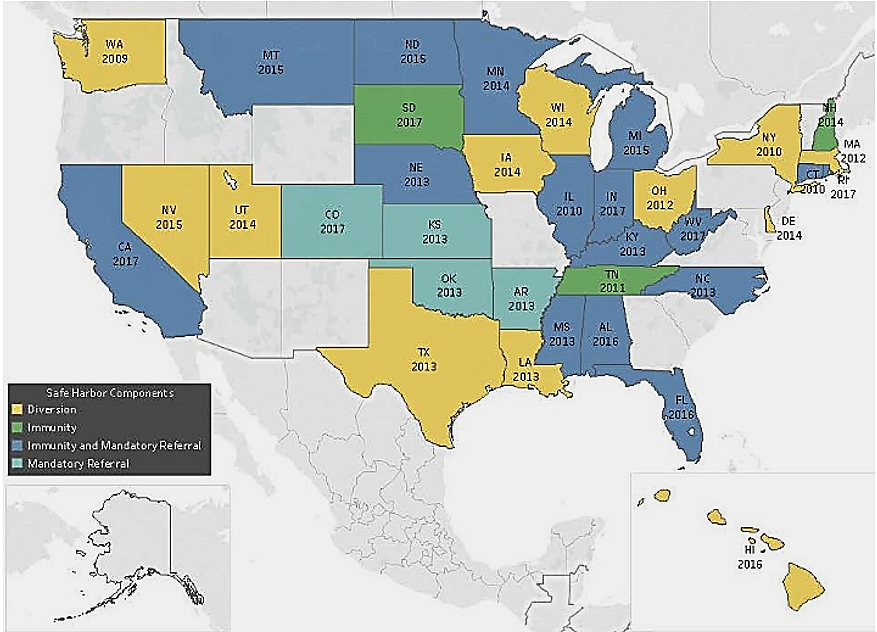
As shown above, 12 states have implemented a safe harbor law through diversion from the juvenile justice system, 3 states use immunity from prosecution only, 16 states use immunity from prosecution with mandatory referral to services and treatment, and 4 states use mandatory referral only.
In phase 2, researchers conducted a quantitative assessment to compare counties that have implemented safe harbor laws with those that have not. Researchers found that the enactment of safe harbor laws had little impact on the number of prostitution-related crimes. However, the passage of safe harbor laws was associated with a statistically significant decline in the number of prostitution-related arrests in counties that have enacted safe harbor legislation relative to those that have not. Specifically, while the total number of prostitution-related arrests dropped in both safe harbor and non-safe harbor states from 2009 through 2015, the decline was steeper for jurisdictions with safe harbor legislation than for jurisdictions without this legislation.
In contrast, investigators found no evidence that youth were systematically being reclassified as victims of sexual abuse and referred to appropriate services. Overall, these findings indicate that the enactment of safe harbor laws did result in fewer prostitution-related arrests, but they did little to prevent the abuse from happening in towns, cities, and neighborhoods throughout the United States.
Researchers in phase 3 interviewed key stakeholders in two states—one state that implemented safe harbor laws with positive findings, and one that implemented these laws with no positive results. In both cases, interviewees felt that safe harbor laws had a positive impact on children as well as the professionals who are responsible for enforcing the law and providing care. At the same time, interviewees almost unanimously emphasized the continuing challenges in providing CSEC victims with specialized services to help them heal and exit the life of commercial sexual exploitation.
The report recommends a comprehensive and holistic approach to commercial sexual exploitation and trafficking that addresses both supply and demand. In addition, the report recommends that future research examine other effective systems of care (e.g., substance abuse treatment) to determine how best to facilitate access to specialized services.
It also identifies several components of successful implementation of safe harbor laws: leadership from the state law enforcement agency, a state coordinating body that is mandated—and empowered—to address CSEC, a concerted effort to redefine children involved in sex trafficking as victims rather than criminals as a means of motivating law enforcement, and planning to ensure that the necessary financial resources are in place to make the intent of safe harbor laws a reality.
Resources:
For a summary of the Office’s work to combat child sex trafficking, access the OJJDP In Focus page, Commercial Sexual Exploitation of Children.
Criminal Connections: Child Pornography and Child Sexual Abuse: October 28–29, 2019
During this training, sponsored by the National Criminal Justice Training Center, participants will learn about the additional trauma that child victims experience when child pornography is involved in sexual abuse cases. The training, to be held in Maynard, MA, will explore investigative strategies that address the relationship between child sexual abuse and child pornography to supplement an investigation and corroborate victim statements. Registration information is available online.
The training will also be held December 4–5, 2019, in Gainesville, FL, and January 27–28, 2020, in West Palm Beach, FL.
 Understanding the Darknet: November 7, 2019
Understanding the Darknet: November 7, 2019
This webinar will teach participants how the Darknet works. Participants will also learn that the way potential criminal activity is facilitated on the Darknet is crucial to investigating and prosecuting child exploitation cases. This event is sponsored by the Midwest Regional Children’s Advocacy Center. Registration information is available online.
Presenting Evidence in Child Forensic Interviews: November 12–13, 2019
Offered by the National Criminal Justice Training Center, this training will explore how to present evidence in cases involving abuse, exploitation, and violence. Participants will practice applying concepts for identifying and assessing evidence in the context of a child-centered, trauma-informed approach. The training will be held in Dallas, TX. Registration information is available online.
Extended Forensic Interview Training: November 13–15, 2019
An extended forensic interview is appropriate for children where the results of a single interview are inconclusive or where there are serious concerns about the child's ability to participate in a single-session interview. An extended forensic interview can be beneficial for a child with developmental delays, cognitive disabilities, or the extremely traumatized child. Offered by the National Children’s Advocacy Center, this training introduces a model for a multisession forensic interview of a child who may be a victim or witness of child abuse or other violent behaviors. The training will be held in Huntsville, AL. Registration information is available online.
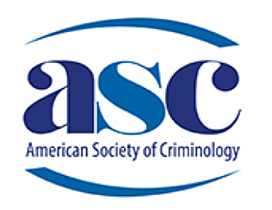 American Society of Criminology Annual Meeting: November 13–16, 2019
American Society of Criminology Annual Meeting: November 13–16, 2019
This meeting, sponsored by the American Society of Criminology, will take place in San Francisco, CA. The theme is “Criminology in the New Era: Confronting Injustice and Inequalities.” The meeting will address the areas of schools, discipline, and the criminal justice system; biological correlates of psychopathy; policing young people; community contexts of race, ethnicity, victimization, and offenders; and legal services for the indigent: client perspectives. Registration information is available online.
Protecting Children in a Digital Age: November 14, 2019
Offered by the National Criminal Justice Training Center, this training will focus on a proactive approach to digital safety that includes setting guidelines and digital citizenship training. Attendees will learn about the most common online issues that children and teens are likely to face, such as cyberbullying, sexting, and the threat posed by online predators. In addition, presenters will share strategies and resources for mitigating threats and helping victims navigate trauma after an incident has occurred. The training will be held in Huntsville, AL. Registration information is available online.
The training will also be held June 16, 2020, in Concord, CA.
Child Homicide Investigations: November 18–19, 2019
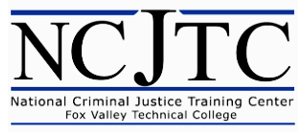 The National Criminal Justice Training Center will hold this training in New Orleans, LA. It will focus on understanding and building relationships between forensic pathologists, homicide investigators, and prosecutors to successfully investigate and prosecute child homicide cases. The training is designed for prosecutors as well as court system, law enforcement, social work, and victim service professionals. Registration information is available online.
The National Criminal Justice Training Center will hold this training in New Orleans, LA. It will focus on understanding and building relationships between forensic pathologists, homicide investigators, and prosecutors to successfully investigate and prosecute child homicide cases. The training is designed for prosecutors as well as court system, law enforcement, social work, and victim service professionals. Registration information is available online.
The training will also be held January 25–26, 2020, in San Diego, CA, Mar 16–17, in Blanco, TX, and May 18–19, in Aurora, CO.
Beyond Google: Discovering Online Resources in Investigations: January 29–30, 2020
Offered by the National Criminal Justice Training Center, this training will discuss open-source online intelligence and information and how to leverage free platforms, databases, and web applications to further investigations of criminal cases. Participants will learn techniques to optimize results using online search engines and Internet resources, and how to complete and serve search warrants for electronic information and databases. The training will be held in West Palm Beach, FL. Registration information is available online.
National Mentoring Summit: January 29–31, 2020

The 10th annual National Mentoring Summit will take place in Washington, DC. Organized by MENTOR: The National Mentoring Partnership and supported by OJJDP, the summit will showcase exemplary program models, collaborations, research, and innovations that have positive implications for strengthening the mentoring field. The summit is the only national convening of youth mentoring professionals, researchers, philanthropic investors, and government and civic leaders that is designed to strengthen and expand quality mentoring relationships for young people across the country. Registration information is available online.
Department of Justice Convenes Meeting of National Public Safety Partnership
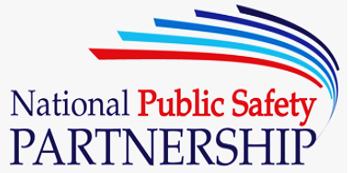 On September 9–11, the National Public Safety Partnership (PSP) held its 2019 symposium in Memphis, TN. Established in June 2017, PSP provides a single point of access to an array of Department of Justice resources, training, and technical assistance for 41 sites working to reduce violent and other serious crimes related to gangs, guns, and drugs.
On September 9–11, the National Public Safety Partnership (PSP) held its 2019 symposium in Memphis, TN. Established in June 2017, PSP provides a single point of access to an array of Department of Justice resources, training, and technical assistance for 41 sites working to reduce violent and other serious crimes related to gangs, guns, and drugs.
The symposium offered about 40 training sessions that addressed a range of topics, including community engagement, crime analysis, collaboration between criminal justice stakeholders, federal partnerships, gun violence, investigations, and technology. The sessions highlighted future assistance that can be provided to the sites through training and technical assistance, consultation, peer exchanges, and other resources.
OJJDP has supported PSP through training and technical assistance on juvenile crime and violence prevention, including best practices on gang prevention, intervention, and suppression, through the National Gang Center. Cynthia Pappas, OJJDP Senior Policy Advisor, worked previously with the pilot site in Newark, NJ, and is currently working with the sites in Birmingham, AL, and Wichita, KS, to support their efforts to investigate, prosecute, and deter violent crime, especially crime involving gun violence, gangs, and drug trafficking. Ms. Pappas also provides resources and guidance to help PSP sites reduce violent crime and increase public safety by exploring new community engagement activities designed to build positive relationships among police and the communities they serve.
Office of Justice Programs’ Blog Discusses AMBER Alerts in Indian Country
The Office of Justice Programs (OJP) has posted a blog discussing AMBER Alerts in Indian country born out of the tragic abduction and murder of 11-year-old Ashlynne Mike of the Navajo Nation in 2016. The tragedy revealed that American Indian tribes lacked access to the AMBER Alert system to assist in the recovery of abducted children.
The blog details last summer’s National AMBER Alert in Indian Country Symposium, sponsored by OJJDP, where Pamela Foster, Ashlynne's mother, shared her story. The blog describes the passage of the Ashlynne Mike AMBER Alert in Indian Country Act and highlights how OJP and OJJDP are working with tribes to integrate AMBER Alerts.
OJJDP Video Message Highlights Restorative Justice
In a new video, OJJDP Administrator Caren Harp and members of OJJDP’s Restorative Justice Working Group share their perspectives on the value of restorative justice practices in the juvenile justice system. Restorative justice focuses on holding offenders personally accountable to their victims and to the community at large—often through face-to-face meetings and reparative actions such as financial restitution to victims, the repair of victims' damaged property, or work for the betterment of the community.
“The juvenile justice system as it operates currently is formal and uses a lot of statutory language and citations, and it keeps the youthful offender away from the victim and allows the offender only to speak through his attorney,” said Administrator Harp. “There are a lot of processes in place that make it kind of sterile and keep the offender from really engaging with his criminal conduct. That’s something that restorative justice changes, because restorative justice looks at crime as harm . . . harm caused by one individual to the detriment of another. A restorative process for both victim and the offender helps them both come together, face to face, and evaluate and assess the harm that’s been done—and how that harm can be repaired.”
The Office’s Restorative Justice Working Group plans to produce a user-friendly guide that will offer standard definitions for the components of restorative justice and its foundational values. The guide will describe planning and implementation and provide a framework that engages all juvenile justice system stakeholders in the restorative justice process.
OJJDP Administrator Discusses Juvenile Justice Reform Act at Conferences
In early August, Administrator Caren Harp provided an overview of the Juvenile Justice Reform Act of 2018 (JJRA) at the 36th Annual Conference of the Tennessee Juvenile Court Services Association in Memphis and the 42nd Juvenile Justice Symposium in Biloxi, MS. JJRA reauthorizes and amends the Juvenile Justice and Delinquency Prevention Act, last reauthorized in 2002.
Administrator Harp discussed a range of topics, including the expansion of program areas that states may support with formula grants, new provisions regarding states’ 3-year plans, and the composition and duties of state advisory groups. In addition, she summarized JJRA provisions regarding juvenile reentry planning, identification and reduction of racial and ethnic disparities, use of the valid court order exception, and transfer of juveniles to criminal court. States must now describe an “effective” system of monitoring for compliance with the core requirements but no longer need to include nonsecure facilities in their monitoring universe.
For more information on JJRA, read OJJDP’s fact sheet and 2018 JJRA redline, which allows users to closely track changes implemented by the legislation.
OJJDP’s Model Programs Guide Offers Resources To Prevent Bullying in Schools
 October is National Bullying Prevention Month, an annual campaign to raise public awareness about the prevalence and consequences of bullying and effective ways to stop this harmful behavior.
October is National Bullying Prevention Month, an annual campaign to raise public awareness about the prevalence and consequences of bullying and effective ways to stop this harmful behavior.
OJJDP’s Model Programs Guide offers a School-Based Bullying Prevention Implementation Guide (I-Guide) for school administrators, teachers and school staff, students, parents, and others in the community who are interested in creating safe school environments by implementing school-based bullying prevention programs. The I-Guide covers all aspects of program implementation, including conducting a needs assessment, obtaining stakeholder buy-in, providing program training, handling unanticipated problems or setbacks, and ensuring long-term sustainability.
The Model Programs Guide also includes evaluations of school-based anti-bullying programs. Programs that are deemed effective encourage collaboration from the entire school community and promote a culture in which students feel comfortable seeking help when they are bullied. The issue of school-based bullying is further explored in the Model Programs Guide’s Bullying Literature Review.
OJJDP Updates Statistical Briefing Book
OJJDP has updated its Statistical Briefing Book:
- Easy Access to Juvenile Populations and related FAQs in the Juvenile Population Characteristics and Hispanic Youth in the Juvenile Justice System sections have been updated to 2018.
- FAQs in the Juvenile Population Characteristics section have been updated, including living arrangements, teen mothers, and high school completion.
- Easy Access to State and County Juvenile Court Case Counts has been updated to include data through 2017.
- FAQs about school-related violent deaths in the Juveniles as Victims section have been updated to include 2017 data.
- FAQs about juveniles in adult jails and prisons have been updated to include 2017 data.
Developed for OJJDP by the National Center for Juvenile Justice, the research division of the National Council of Juvenile and Family Court Judges, the Statistical Briefing Book offers easy online access to statistics on a variety of juvenile justice topics.
Two New Data Snapshots on Juveniles in Court Available
The OJJDP Statistical Briefing Book has added two new Data Snapshots that draw on data from OJJDP’s National Juvenile Court Data Archive:
- Characteristics and Trends of Delinquency Cases Resulting in Probation
- Characteristics of Cases Judicially Waived from Juvenile Court to Criminal Court
Access the full list of Data Snapshots available from the Statistical Briefing Book.
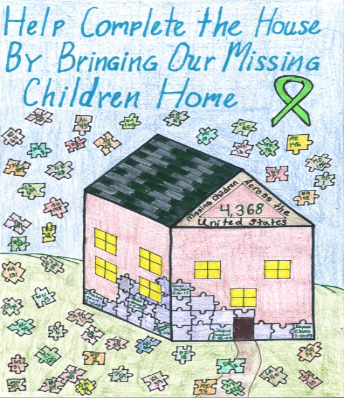 Shown above is the winning poster for the 2019 Missing Children's Day poster contest. This artwork will inspire the poster and artwork for the 2020 Missing Children's Day.
Shown above is the winning poster for the 2019 Missing Children's Day poster contest. This artwork will inspire the poster and artwork for the 2020 Missing Children's Day.
OJJDP Accepting Nominations for the 37th Annual Missing Children’s Day Awards
Do you know an individual or organization who has made a significant contribution to protecting children between January 1, 2019, and November 14, 2019?OJJDP is accepting nominations until November 14, 2019, for the following Missing Children's Day awards:
- Attorney General's Special Commendation
- Missing Children's Law Enforcement Award
- Missing Children's Child Protection Award
- Missing Children's Citizen Award
Award winners will be honored at the National Missing Children's Day ceremony on May 20, 2020, in Washington, DC.
OJJDP Roundtable: Reducing Out-of-Home Placement and Improving Community Supervision
In 2017, OJJDP launched the Juvenile Justice Systems Improvement Promising Practices initiative. ICF Incorporated, LLC, received a grant award to synthesize, collect, and interpret the outcomes, models, and best practices of previously funded OJJDP projects. The initiative aims to inform the juvenile justice field about promising practices and lessons learned from the states through roundtable discussions and the development of resources and tools to support states, local governments, and communities in improving outcomes for youth.
As part of the initiative, OJJDP held the third of four expert roundtable discussions in Washington, DC, on July 9. The meeting focused on system improvement efforts to reduce out-of-home placement and improve community supervision for youth transitioning out of the juvenile justice system. Participants represented a range of agencies and included OJJDP’s Deputy Administrator Chyrl Jones, Deputy Associate Administrator Dr. Sanzanna Dean, and Program Manager Gwendolyn Dilworth. These participants, along with ICF’s project team—representatives from Georgetown University’s Center for Juvenile Justice Reform and several members of a panel of juvenile justice experts—discussed how best to implement, lead, and sustain these system improvements in the states.
In group discussions and breakout sessions, participants highlighted the importance of developing a cross-system planning team; offering information, resources, and training to the judiciary; ensuring buy-in from judges; developing well-defined data to facilitate collaboration with the judiciary, the legislature, and local commissioners; and providing courts with the necessary tools to track data and monitor outcomes.
Participants also discussed components that are key to the success of community supervision improvement efforts: reinvesting in resources for training and the rollout of new protocols to the community, involving case workers early in the planning of new protocols, and using a local “champion” to help ensure staff support. Other key components include incorporating regular feedback from parents and youth with experience in the juvenile justice system, developing relationships with potential employers in the community, and developing a statewide system for data tracking.

On September 12, 2019, OJJDP hosted a public meeting of the Coordinating Council on Juvenile Justice and Delinquency Prevention. The meeting highlighted a Department of Education program that supports supplemental educational services for at-risk and delinquent youth. In addition, the event featured testimonial from a 4-H Club member on the impact mentoring can have on a young person’s educational and vocational success.
 At the September 12, 2019, meeting of the Coordinating Council on Juvenile Justice and Delinquency Prevention in Washington, DC, Faatimah Muhammad (foreground), Supervisory Education Program Specialist at the Department of Education’s Office of Elementary and Secondary Education (OESE), joined other OESE staff (shown in the background) to discuss opportunities available for partnerships and funding through Title I, Part D of the Elementary and Secondary Education Act.
At the September 12, 2019, meeting of the Coordinating Council on Juvenile Justice and Delinquency Prevention in Washington, DC, Faatimah Muhammad (foreground), Supervisory Education Program Specialist at the Department of Education’s Office of Elementary and Secondary Education (OESE), joined other OESE staff (shown in the background) to discuss opportunities available for partnerships and funding through Title I, Part D of the Elementary and Secondary Education Act.These resources are offered under Title I, Part D of the Elementary and Secondary Education Act, which contains provisions for disadvantaged students. In fiscal year (FY) 2019, the program awarded $46.4 million to state education agencies through Subpart 1, $104.3 million to local agencies through Subpart 2, and $1.2 million to support the national technical assistance center.
Ms. Muhammad said she and her staff would attend the OJJDP State Relations and Assistance Division National Training Conference in Kansas City, MO, in late September to share information with states about partnerships and funding opportunities available through the Department of Education. Opportunities for collaboration exist not only through OESE, but also through the Department’s Office of Special Education and Rehabilitative Services; Office of Civil Rights; and Office of Career, Technical, and Adult Education.
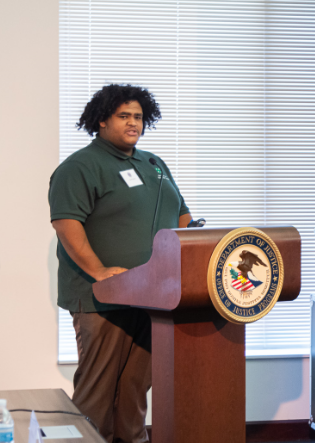 Clyde Van Dyke received the 2019 4-H Youth in Action Award for his commitment to using technology to support community change. “There really are no words that can fully express my gratitude to OJJDP and 4-H, because my life would have looked very different if I hadn’t been welcomed into the 4-H family.”
Clyde Van Dyke received the 2019 4-H Youth in Action Award for his commitment to using technology to support community change. “There really are no words that can fully express my gratitude to OJJDP and 4-H, because my life would have looked very different if I hadn’t been welcomed into the 4-H family.”His life changed when a friend invited him to a 4-H technology program in his hometown of Johnson City, NY. Not only did he learn about the technology field, but he was exposed to resources and opportunities that motivated him to do better in school and in life. “I walked into the next few years of school with a new mindset and a determination to try my hardest in school,” Clyde said.
Through the 4-H Club, Mr. Van Dyke learned how to create maps to visualize data, a technique known as “geospatial mapping.” He now uses geospatial mapping to help communities better understand the prevalence, trends, and contributing factors to critical issues such as the opioid epidemic. He also mentors young people in elementary schools near his hometown.
“I’m proud to say that because of 4-H and the adults who have supported me, I’m not a dropout,” he said. “I graduated from high school in June and just started college at the State University of New York at Delhi to pursue a career in digital forensics—a path I never would have discovered without 4-H.”
OJJDP has long supported the 4-H Club and other national and multistate mentoring programs. In FY 2018, OJJDP awarded more than $73.3 million through its Mentoring Opportunities for Youth initiative.
The Coordinating Council on Juvenile Justice and Delinquency Prevention is an independent body within the executive branch of the federal government operated under the Federal Advisory Committee Act. The council's primary functions are to coordinate federal juvenile delinquency prevention programs, federal programs and activities that detain or care for unaccompanied juveniles, and federal programs relating to missing and exploited children.
The council is made up of 22 members—13 ex officio and affiliate members and 9 practitioners. The ex officio members are: the Attorney General; the Administrator of the Office of Juvenile Justice and Delinquency Prevention; the Secretaries of the U.S. Departments of Education, Health and Human Services (HHS), Housing and Urban Development, and Labor; the Assistant Secretary of Immigration and Customs Enforcement in the U.S. Department of Homeland Security; the Director of the Office of National Drug Control Policy; and the Chief Executive Officer of the Corporation for National and Community Service. Affiliate members are the Secretaries of the U.S. Departments of Agriculture, Defense, and the Interior, and the Administrator of the Substance Abuse and Mental Health Services Administration of HHS. The nine juvenile justice practitioner members are appointed by the Speaker of the House of Representatives, the Senate Majority Leader, and the President of the United States. In accordance with the Federal Advisory Committee Act, the Council holds public meetings up to four times a year in which members discuss activities to facilitate and support cross-agency coordination.
Nationwide, the opioid crisis is increasing health care demands and putting pressure on law enforcement, emergency response, and social services. The issues are particularly serious in rural areas, which have high rates of poverty and unemployment, limited medical and social services, and transportation challenges. A recent Harvard School of Public Health survey found that rural Americans identify drug addiction or abuse (including opioids) and economic concerns as the two biggest problems facing their local communities.
At the September 25, 2019, meeting of the Federal Advisory Committee on Juvenile Justice (FACJJ), Betty-Ann Bryce, Special Advisor on Rural Public Health, Education and Treatment at the Office of National Drug Control Policy, highlighted new federal resources available to help rural areas. Ms. Bryce is currently on detail to ONDCP from the Department of Agriculture (USDA).
The Rural Opioid Federal Interagency Working Group, chaired by ONDCP and USDA, has produced a guide titled Federal Resources for Rural Communities to Help Address Substance Use Disorder
and Opioid Misuse. The guide offers a “one-stop-shop” listing for rural leaders seeking federal funding and partnership opportunities to address the opioid crisis.
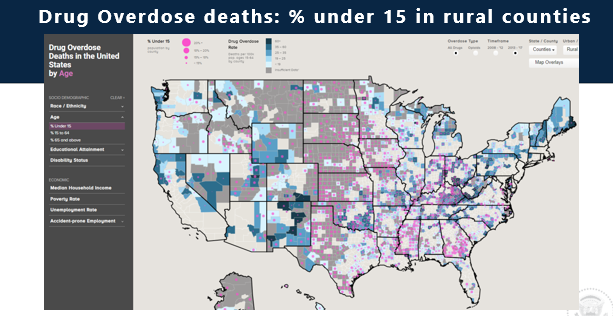 The areas highlighted in pink in the map above show national drug overdose death rates for children younger than 15. The Community Assessment Tool also provides breakdowns of these statistics by individual states and counties. In addition, the tool offers information at the national, state, and county levels for individuals ages 15–64.
The areas highlighted in pink in the map above show national drug overdose death rates for children younger than 15. The Community Assessment Tool also provides breakdowns of these statistics by individual states and counties. In addition, the tool offers information at the national, state, and county levels for individuals ages 15–64.Last year, USDA launched the Community Assessment Tool, an interactive database to help community leaders assess how and why the opioid epidemic is impacting their regions. The tool allows users to analyze drug overdose deaths according to geographic area, time frame, and socioeconomic and demographic factors such as race/ethnicity, unemployment rate, educational level, and age.
Ms. Bryce said new data will soon be added to the tool to complete the rural picture. Information will include a region’s level of broadband access, rural transit gaps, treatment centers, health professional shortage areas, and areas of persistent poverty.
The FACJJ meeting also featured a presentation
by the Office of Elementary and Secondary Education (OESE) on Department of Education programs that fund supplemental education services for youth in juvenile and adult correctional facilities, youth in residential facilities for neglected children and youth, and community day programs for neglected or delinquent youth. Supervisory Education Program Specialist Faatimah Muhammad and Program Officer Jasmine Akinsipe outlined the services available through Title I, Part D of the Elementary and Secondary Education Act.
They also discussed opportunities for partnerships with other components of the Department of Education as well as cross-system collaboration at the national, state, regional, and local levels. OESE presented on these topics in September at a meeting of the Coordinating Council on Juvenile Justice and Delinquency Prevention in Washington, DC. For more information, read “News From the Coordinating Council on Juvenile Justice and Delinquency Prevention” in this issue.
OJJDP Administrator Caren Harp presented certificates of appreciation to the FACJJ members in recognition of their dedication and service to the juvenile justice field.
The FACJJ meeting concluded with activity reports and recommendations by the heads of each of the three FACJJ subcommittees—Special Topics, Facilitating Compliance With the Juvenile Justice Reform Act, and Educating the Field.
The FACJJ meeting was held in Kansas City, MO, concurrent with the OJJDP State Relations and Assistance Division National Training Conference.